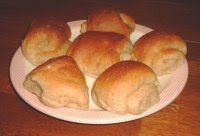 George Santayana said, “The family is one of nature's masterpieces.” It wouldn't surprise me is he was talking about peppers. It's certainly a family that warms my heart.
George Santayana said, “The family is one of nature's masterpieces.” It wouldn't surprise me is he was talking about peppers. It's certainly a family that warms my heart.Dried peppers make there way into our kitchen most commonly through the spice rack, although dried hot peppers can be found if you cruise the Mexican food aisle. Many peppers are made from dried capsicums. This is different from the more conventional black or white pepper, ground from peppercorns. Different pepper products vary wildly in the amount of heat they have so, it's a good idea to know which is which.
Hot Pepper Flakes
Their flavor is quite fiery and there can be a lot of seeds in with the flakes. Use with caution. Sprinkle sparingly over foods before, during, or after cooking to add a kick to almost any dish. Adding a touch to a tomato based pasta sauce, or sprinkling over pizza slices is a great way to spice things up. You can buy them already prepared or you can my your own by grinding dried red peppers in a mortar.
Paprika
This is the mildest of all peppers in the family and can be found in sweet (mild) and hot (Hungarian) forms. Most times the sweet versions are the most versatile, but I favor the hot because of the more intense flavor. Spanish paprika is smoked and they prefer to call it pimentone. Commonly used in Hungarian and Spanish dishes it adds subtle heat and complexity to food.
Cayenne
Made from one of the hottest varieties of chilies (that are edible, anyway), cayenne is used frequently in Mexican and Cajun foods. It adds real heat and flavor so, use cautiously. It is also sold as red pepper.
Chili Powder
Chili Powder is actually a blend of chilies, garlic, cumin and oregano. Different brands will differ in heat, but most are relatively mild. Chili powder adds authenticity and piquancy to Mexican, Indian, and Southwestern dishes.
Photo by Irina Ignatova








